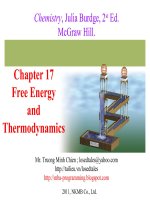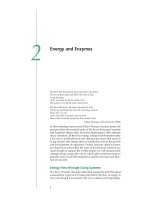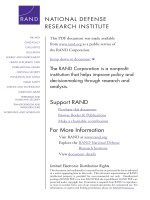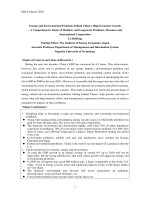Towards high energy and high power density lithium rich cathode materials for future lithium ion batteries exploring and understanding mechanisms and role of transformation
Bạn đang xem bản rút gọn của tài liệu. Xem và tải ngay bản đầy đủ của tài liệu tại đây (13.41 MB, 223 trang )
TOWARDS HIGH-ENERGY AND HIGH-POWER DENSITY
LITHIUM-RICH CATHODE MATERIALS FOR FUTURE
LITHIUM-ION BATTERIES: EXPLORING AND UNDERSTANDING
MECHANISMS AND ROLE OF TRANSFORMATION
SONG BOHANG
NATIONAL UNIVERSITY OF SINGAPORE
2013
TOWARDS HIGH-ENERGY AND HIGH-POWER DENSITY
LITHIUM-RICH CATHODE MATERIALS FOR FUTURE
LITHIUM-ION BATTERIES: EXPLORING AND UNDERSTANDING
MECHANISMS AND ROLE OF TRANSFORMATION
SONG BOHANG
(B.Sc.)
A THESIS SUBMITTED
FOR THE DEGREE OF DOCTOR OF PHILOSOPHY
DEPARTMENT OF MECHANICAL ENGINEERING
NATIONAL UNIVERSITY OF SINGAPORE
2013
Declaration
I
DECLARATION
I hereby declare that the thesis is my original work and it has been written by me in
its entirety. I have duly acknowledged all the sources of information which have
been used in the thesis.
This thesis has also not been submitted for any degree in any university previously.
________________________
SONG BOHANG
09 August 2013
Acknowledgements
II
ACKNOWLEDGEMENTS
First and foremost, I would like to express my deepest and the most sincere gratitude
to my supervisors, Prof. Lu Li and A/Prof. Lai Man On, for their invaluable guidance
and consistent support throughout my four years’ study at the National University of
Singapore. Their incisive mind and unique perspectives always enlightened me of
new insights into research topics, and it is extremely pleasant to work with them. I
am also grateful to National University of Singapore for the financial support.
I would like to express my sincere thanks to my seniors, Dr. Xiao Pengfei and Dr.
Wang Hailong for introducing me to this graduate program, teaching and inspiring
me a lot in experiments and life. I would also like to thank Dr. Liu Hongwei and
A/Prof. Liu Zongwen for their professional skills on transmission electron
mircoscopy characterizations. In addition, I would like to thank Dr. Ye Shukai, Dr.
Wang Shijie, Dr. Zhang Zhen, Dr. Xia Hui, Dr. Yan Feng, Dr. Zhu Jing, Dr. Ding
Yuanli, Mr. Lin Chunfu, Mr. Chen Yu, Mr. Ding Bo, Mr. Yan Binggong and Mr.
Helmy for their generous encouragement and valuable suggestions on lab work. A
special appreciation goes to my friend, Mr. Mi Yu for the unstoppable support during
my four years’ study. I would like to acknowledge the following staff in Materials
Laboratory: Mr. Thomas Tan, Mr. Ng Hongwei, Mr. Khalim, Mr. Juraimi and Dr.
Aye Thein for providing professional technical support.
Finally, I would like to express my utmost thanks to my parents and all other family
members. Without their understandings and endless love, I wouldn’t make it happen
to accomplish this entire study.
Summary
III
SUMMARY
Developing high-energy and high-power density cathode materials for
next-generation lithium ion batteries (LIB) is important and urgent because of high
demand of long lasting power sources, such as portable devices, power tools and
electric vehicles (EVs). In addition to the cathode materials developed in the past
two decades, a new family of Li-rich layered cathodes has received great interests
due to their high theoretical and reversible capacities. However, several drawbacks
still gap them from real applications, for instance first irreversible capacity loss, poor
rate capability and voltage decay during electrochemical cycling. To conquer these
critical issues, this study firstly focuses on exploring the mechanisms behind the
voltage decay which is highly associated with inevitable phase transformation in
local structure. To solve this issue, a doping strategy taking advantages of cation ions
is proposed to slow down the progress of this phase transformation. Furthermore,
inspired by a positive aspect on rate performance as a result of serious
transformation, several surface modification strategies are proposed to enhance the
rate capability of the Li-rich layered cathode, which involves a similar phase
transformation during preparation but only occurs in the particle surface regions.
Systematic characterizations on crystal structure and solid state chemistry are
performed to lead to comprehensive understandings on various evolutions of
corresponding electrochemical behaviors.
Table of Contents
IV
Table of Contents
DECLARATION I
ACKNOWLEDGEMENTS II
SUMMARY III
LIST OF FIGURES IX
LIST OF TABLES XXII
CHAPTER 1. INTRODUCTION AND LITERATURE REVIEW 1
1.1 Basic Concepts of Rechargeable Li-ion Batteries 2
1.2 Literature Review 3
1.2.1 Overview of Electrode Materials 3
1.2.2 Cathode Materials Within Spinel Structure 5
1.2.3 Cathode Materials Within Olivine Structure 8
1.2.4 Cathode Materials Within Layered Structure 11
1.2.4.1 Conventional LiCoO
2
, LiNiO
2
and LiMnO
2
11
1.2.4.2 Other Derivatives 13
1.2.5 Cathode Materials Within Two-phase Integrated Structure 19
1.2.5.1 Origins of Designation and Basic Concepts 19
1.2.5.2 Critical Issues and Achieved Improvements 22
1.3 Present Work on Improving Li-rich Layered Cathodes 26
CHAPTER 2. EXPERIMENTAL APPROACH 28
2.1 Synthesis Routes 28
Table of Contents
V
2.1.1 Hydroxide Based Co-precipitation Method 28
2.1.2 Spray-dryer Assisted Sol-gel Method 29
2.2 Material Characterizations 29
2.2.1 Elemental Analysis 29
2.2.2 X-ray Diffraction and Rietveld Refinement 30
2.2.3 Raman Spectroscopy 30
2.2.4 Electron Microscopy 30
2.2.5 X-ray Photoelectron Spectroscopy 31
2.2.6 TGA/DSC Characterization 31
2.3 Characterization of Electrochemical Properties 31
2.3.1 Preparation of Positive Electrode and Battery Assembly 31
2.3.2 Galvanostatic Charge/Discharge Cycling 32
2.3.3 Cyclic Voltammetry 33
2.3.4 Electrochemical Impedance Spectroscopy 33
2.3.5 dQ/dV Plots 33
CHAPTER 3. Ru DOPING ON 3a SITE IN Li-RICH LAYERED CATHODES 35
3.1 Motivation of the Doping Strategy 35
3.2 Material Preparation 36
3.3 Crystallographic Characterizations 37
3.4 Electrochemical Properties 41
3.5 Discussions on Facile Phase Transformation upon Long-term Cycling 56
3.5.1 Analysis Based on Electrochemical Behaviors 56
Table of Contents
VI
3.5.2 XPS analysis 59
3.5.3 Analysis Based on TEM-EDS and ICP 62
3.5.4 Analysis based on HRTEM 64
3.5.5 Analysis Based on Ex-situ XRD 69
3.5.6 Influence of Spinel-like Phase on Electrochemical Performance 70
3.6 Summary 72
CHAPTER 4. Cr DOPING ON 3a SITE IN Li-RICH LAYERED CATHODES 74
4.1 Motivation of the Doping Strategy 74
4.2 Material Preparation 75
4.3 Crystallographic Characterization 76
4.4 Electrochemical Properties 82
4.5 Suppression of Phase Transformation upon Long-term Cycling 86
4.5.1 XPS Analysis 86
4.5.2 Cycle Performance 90
4.5.3 Analysis Based on Discharge Curves and dQ/dV 93
4.5.4 Ex-situ XRD 97
4.6 Summary 98
CHAPTER 5. GRAPHENE-INVOLVED SURFACE TREATMENT ON LI-RICH LAYERED CATHODES 100
5.1 Motivation of the Modification Strategy 100
5.2 Material Preparation 101
5.3 Crystallographic Characterization 102
5.4 Electrochemical Properties 112
Table of Contents
VII
5.4.1 Galvanostatic Charge/Discharge Behaviors 112
5.4.2 Cyclic Voltammetry 115
5.5 Discussions on Enhanced Rate Capability Led by Phase Transformation 117
5.5.1 XPS Analysis 118
5.5.2 Cycling Performance and Enhanced Rate Capability 121
5.5.3 Analysis Based on Discharge Curves and dQ/dV 125
5.5.4 Analysis Based on EIS 128
5.6 Summary 130
CHAPTER 6. CARBON BLACK-INVOLVED SURFACE TREATMENT ON LI-RICH LAYERED
CATHODES 131
6.1 Motivation of the Modification Strategy 131
6.2 Material Preparation 132
6.3 Crystallographic Characterizations 132
6.4 Electrochemical Properties 139
6.4.1 Galvanostatic Charge/Discharge Behaviors 139
6.4.2 Cyclic Voltammetry 141
6.5 Discussion on Enhanced Rate Capability Led by Phase Transformation 144
6.5.1 XPS Analysis 144
6.5.2 Analysis Based on TEM-EDS 146
6.5.3 Cycling Performance and Enhanced Rate Capability 148
6.5.4 Analysis Based on Discharge Curves and dQ/dV 151
6.5.5 Analysis Based on EIS 153
Table of Contents
VIII
6.6 Summary 155
CHAPTER 7. SURFACE COATING OF CARBON ON LI-RICH LAYERED CATHODES 157
7.1 Motivation of the Modification Strategy 157
7.2 Material Preparation 157
7.3 Crystallographic Characterizations 158
7.4 Electrochemical Properties 166
7.5 Discussion on Enhanced Cyclability and Rate Capability 169
7.5.1 XPS Analysis 169
7.5.2 Enhanced Cyclability and Rate Capability 172
7.5.3 Analysis Based on Discharge Curves and dQ/dV 173
7.6 Summary 176
CHAPTER 8. CONCLUSIONS AND RECOMMENDATIONS 177
8.1 Conclusions 177
8.2 Limitations and Recommendations 181
REFERENCES 184
LIST OF PUBLICATIONS 197
List of Figures
IX
LIST OF FIGURES
Fig. 1.1 Schematic illustration of lithium-ion battery [4]. 2
Fig. 1.2 Crystal structure of LiMn
2
O
4
. Green tetrahedrons indicate locations of Li ions; pink
octahedrons indicate locations of Mn ions; red spheres indicate O ions. 5
Fig. 1.3 Charge and discharge curves: (a) Li(Ni
0.5
Mn
1.5
)O
4
, (b) LiAl
x
Mn
2-x
O
4
, (c) LiCo
1/3
Ni
1/3
Mn
1/3
O
2
,
(d) LiFePO
4
, and (e) Li(Li
1/3
Ti
5/3
)O
4
[27]. 8
Fig. 1.4 Crystal structure of LiFePO
4
: green spheres indicate Li ions, blue polygons indicate FeO
6
octahedra; yellow polygons indicate PO
4
tetrahedra. 9
Fig. 1.5 Models of superstructural LiCoO
2
: (a) red spheres indicates O ions, green octahedrons
indicate positions of Li ions, blue octahedrons indicate the positions of Co ions; (b) View along
the c-axis of (a), the trigonal arrangement of O ions is similar with HCP structure where Li and
Co are located at the triangular centers alternatively. 11
Fig. 1.6 Capacity of LiNi
1/2
Mn
1/2
O
2
prepared by ion-exchange at different charge and discharge
conditions: (a) charge and discharge curves of a Li/LiNi
1/2
Mn
1/2
O
2
cell operated at a rate of 0.1
mA·cm
-2
in voltage range of 2.5 - 4.3 V for 30 cycles [49] and (b) discharge curves at various C
rates. Cell was charged at C/20 to 4.6 V, held at 4.6 V for 5 hours and discharge at different
rates. 1 C corresponds to 280mA·g
-1
[50]. 14
Fig. 1.7 Models of superstructural LiNi
1/3
Co
1/3
Mn
1/3
O
2
: (a) corners of octahedrons indicate O
ions; blue spheres indicate Li ions; different color octahedrons indicate different transition
metal positions; (b) a schematic illustration of crystal with a superstructural (Ni
1/3
Co
1/3
Mn
1/3
)O
2
layer based on triangular basal net of sites in the α-NaFeO
2
-type structure. 16
List of Figures
X
Fig. 1.8 Rate-capability tests on a Li/LiCo
1/3
Ni
1/3
Mn
1/3
O
2
cell operated at 30°C, where the cell was
charged at constant current of 0.6 mA cm
−2
, then held at a constant voltage of 4.6 V for 4 h,
followed by discharge at different current densities: (a)19.2 mA·cm
−2
(2400 mA·g
−1
based on
LiCo
1/3
Ni
1/3
Mn
1/3
O
2
sample weight), (b) 12.4 (1600), (c) 6.4 (800), (d) 3.2 (400), (e) 1.6 (200), (f)
0.8 (100), and (g) 0.4 (50) [63] 17
Fig. 1.9 Performance of Li(Ni
1/3
Co
1/3
Mn
1/3
)O
2
cells at the current density 100 mA·g
-1
cycled to
different upper cut-off potentials of 4.2, 4.4 and 4.6 V [64]. 17
Fig. 1.10 Compositional phase diagram showing the electrochemical reaction pathways for a
xLi
2
MnO
3
·(1-x)LiMO
2
material. Processes of 1.1 – 1.3 corresponds to the correlated chemical
reactions shown in equations 1.1 – 1.3 [60]. 21
Fig. 1.11 Schematic illustration of Li
2
MnO
3
region from layered-like to spinel-like configuration
transition during delithiation process in xLi
2
MnO
3
-(1-x)LiMO
2
[60]. 22
Fig. 1.12 Charge/discharge profiles of Li
1.2
Ni
0.2
Mn
0.6
O
2
cathode material [89]. 22
Fig. 1.13 Electrochemical discharge profiles for Li/Li
2
MnO
3
_Ni850(C) cell between (a) 4.6–2.0 V
for 45 cycles and (b) 4.4–2.5 V for an additional∼20 cycles. The corresponding dQ/dV plots for
the data in (b) are shown in (c) [99]. 24
Fig. 3.1 (a) XRD patterns of Li(Li
0.2-x
Mn
0.54
Ni
0.13
Co
0.13-x
Ru
x
)O
2
(x=0, 0.01, 0.03 and 0.05). Insets
show typical reflections of (020)
M
and (110)
M
belonging to monoclinic Li
2
MnO
3
component
within the 2θ range of 20-24°, (b) Evolution of lattice constants a and c, and Li slab distance as
a function of Ru content with respect to LiNi
1/3
Co
1/3-z
Ru
z
Mn
1/3
O
2
component, (c) Lattice
constant a, unit cell volume and weight fraction vs. x with respect to Li
2
MnO
3
component.
Note that Li(Li
0.2
Mn
0.54
Ni
0.13
Co
0.13-x
Ru
x
)O
2
can also be written in mass ratio form of
List of Figures
XI
0.55Li
2
MnO
3
·0.45LiNi
1/3
Co
1/3-z
Ru
z
Mn
1/3
O
2
37
Fig. 3.2 Scanning electron micrograph of Li(Li
0.2
Mn
0.54
Ni
0.13
Co
0.13-x
Ru
x
)O
2
: (a) x=0, (b) x=0.01, (c)
x=0.03 and (d) x=0.05. 41
Fig. 3.3 Electrochemical cycles of Li(Li
0.2
Mn
0.54
Ni
0.13
Co
0.13
)O
2
charged and discharged between
2.0 and 4.8 V at 0.05 C rate: (a) first and second charge and discharge profiles and (b)
differential capacity vs. voltage for Li(Li
0.2
Mn
0.54
Ni
0.13
Co
0.13
)O
2
. 41
Fig. 3.4 1st
charge and discharge profiles vs. voltage of Li(Li
0.2-x
Mn
0.54
Ni
0.13
Co
0.13-x
Ru
x
)O
2
(x = 0,
0.01, 0.03 and 0.05) at 0.05 C rate. Inset shows performance at high rate of 1 C. 44
Fig. 3.5 Discharge profiles of Li(Li
0.2-x
Mn
0.54
Ni
0.13
Co
0.13-x
Ru
x
)O
2
(x = 0, 0.01, 0.03 and 0.05) at 2 C
rate, corresponding to 1st, 2nd, 50th, 100th and 200th cycles. 46
Fig. 3.6 Cycling performance of Li(Li
0.2
Mn
0.54
Ni
0.13
Co
0.13
)O
2
and Li(Li
0.19
Mn
0.54
Ni
0.13
Co
0.12
Ru
0.01
)O
2
at different rates of 0.2 C and 2 C. Testing mode of cycling for inset is 0.05 C for a first cycle
followed by 2 C cycles in sequence. 48
Fig. 3.7 Cycling performance comparison between pristine Li(Li
0.2
Mn
0.54
Ni
0.13
Co
0.13
)O
2
and
modified Li(Li
0.19
Mn
0.54
Ni
0.13
Co
0.12
Ru
0.01
)O
2
as cathode materials. Testing conditions: 2 C,
2.0-4.8 V, 25 ℃. 51
Fig. 3.8 Discharge curves of (a) pristine, and (b) modified materials as cathodes at various rates. 52
Fig. 3.9 (a) EIS spectra of pristine and modified samples of Li(Li
0.2-x
Mn
0.54
Ni
0.13
Co
0.13-x
Ru
x
)O
2
(x =
0, 0.01) with respect to 1st, 20th and 100th cycles at same state of discharge process, and
typical plots of |Z
Re
| and |Z
Im
| vs. ω
-1/2
at the potential of 3.5 V corresponding to (b)
Li(Li
0.2
Mn
0.54
Ni
0.13
Co
0.13
)O
2
, (c) Li(Li
0.19
Mn
0.54
Ni
0.13
Co
0.12
Ru
0.01
)O
2
during first discharge process
with respective linear fit to show difference in Warburg coefficient, (d) comparison of average
List of Figures
XII
A
w
values with respect to pristine and modified samples as a function of cycle number. 55
Fig. 3.10 Normalized discharge profiles of 1
st
and 50
th
cycle of LiNi
1/3
Co
1/3
Mn
1/3
O
2
(2.5 - 4.6 V) and
LLNCM at 0.2 C rate. 56
Fig. 3.11 Charge and discharge profiles of (a) LLNCM and (b) LLNCMR. Square and circle curves
correspond to the first 0.05 C cycle and the last 0.05 C cycle after 700 cycles at 2 C rate,
respectively. Insets show the second and the 700
th
charge and discharge cycles at 2 C. 57
Fig. 3.12 Discharge capacity proportion vs. cycle number of LLNCM and LLNCMR obtained from
2.0 to 4.8 V at 2 C. 58
Fig. 3.13 XPS spectra of pristine LLNCM before and after cycling: (a) Ni 2p spectrum, (b) Co 2p
spectrum, and (c) Mn 2p spectrum 59
Fig. 3.14 XPS spectra of modified LLNCMR before and after cycling: (a) Ni 2p spectrum, (b) Co 2p
spectrum, and (c) Mn 2p spectrum 59
Fig. 3.15 Typical TEM image of a cycled LLNCM with four-spot EDS analysis results represented
by atomic ratio of Mn, Ni and Co. 62
Fig. 3.16 Chemical composition of two cathodes measured by ICP before and after cycling: (a)
LLNCM and (b) LLNCMR. 63
Fig. 3.17 A and B. High-resolution transmission electron microscope (HRTEM) image with
corresponding indexed Fast Fourier Transform (FFT) of as-prepared LLNCM, C. Schematic
structure of monoclinic Li
2
MnO
3
, and D. SAED pattern from [1-10] zone axis in Li
2
MnO
3
(C2/m). 64
Fig. 3.18 A, B and C: Surface region HRTEM bright field image of long-term cycled LLNCM with
corresponding Fast Fourier Transform (FFT) and indexing of FFT image, and D: The
short-ordered transformed spinel-like with untransformed nanodomains of bulk region in the
List of Figures
XIII
same grain. Four sub-areas have been applied FFT and indexed 65
Fig. 3.19 A and B: HRTEM bright field image of long-term cycled LLNCMR with corresponding
Fast Fourier Transform, C: Fourier filtered image of pattern A, D, E: SAED patterns indexed as
[10-1] tetrogonal-Li
2
Mn
2
O
4
and [110] fcc-LiMn
2
O
4
, respectively, and G: Fourier filtered image
of surface region indicates totally transformed regularly-aligned phase. 68
Fig. 3.20 Bright field STEM image of a cycled LLNCMR particle. The line in the image indicates
the area chosen for a line scan EDS analysis. 69
Fig. 3.21 Selected portions of XRD patterns of LLNCMR sample (before and after cycling) 69
Fig. 3.22 Absolute values of discharge capacity corresponding to contributions above 3.5 V and
below 3.5 V at 2 C. 70
Fig. 3.23 Cycling performance of LLNCMR between 2.0 and 4.8 V at 2 C. 71
Fig. 4.1 XRD patterns of the prepared Li(Li
0.2
Mn
0.54
Ni
0.13
Co
0.13-x
Cr
x
)O
2
(x = 0, 0.03, 0.06, 0.10 and
0.13). The evolution of the lattice constants (a, c), unit cell volumes both in the
LiNi
1/3
Co
1/3-y
Cr
y
Mn
1/3
O
2
phase and weight fraction of each phase are compared based on
Rieveld refinement results. 76
Fig. 4.2 XRD patterns of prepared Li(Li
0.2
Mn
0.54
Ni
0.13
Co
0.13-x
Cr
x
)O
2
(x = 0, 0.03, 0.06, 0.10 and 0.13)
using Na
2
CO
3
precursor. 77
Fig. 4.3 Rietveld refinement on the XRD pattern of Li(Li
0.2
Mn
0.54
Ni
0.13
Co
0.13-x
Cr
x
)O
2
(x = 0.03). R
wp
= 12.3 %. Data here are the same as those in Fig. 4.1. 78
Fig. 4.4 Chromium, cobalt, nickel, manganese and oxygen elemental mappings using TEM on
Li(Li
0.2
Mn
0.54
Ni
0.13
Co
0.07
Cr
0.06
)O
2
sample confirms a uniform distribution of elements after
synthesis. 80
List of Figures
XIV
Fig. 4.5 SEM images of (a) and (a’) x=0, (b) and (b’) x = 0.03, (c) and (c’) x = 0.06, (d) and (d’) x =
0.10, (e) and (e’) x = 0.13 of Li(Li
0.2
Mn
0.54
Ni
0.13
Co
0.13-x
Cr
x
)O
2
samples. 81
Fig. 4.6 SEM image of carbonate precursor (Mn
0.54
Ni
0.13
Co
0.07
Cr
0.06
)(CO
3
)
0.83
. 82
Fig. 4.7 Window-opening charge/discharge curves with increase in voltage ranging: 2.0 - 4.0 V,
2.0 - 4.2 V, 2.0 - 4.4 V, 2.0 - 4.5 V, 2.0 - 4.6 V and 2.0 - 4.8 V of Li(Li
0.2
Mn
0.54
Ni
0.13
Co
0.13-x
Cr
x
)O
2
cells (x = 0, 0.03, 0.06, 0.10 and 0.13). Testing rate was fixed at C/20 at room temperature. 83
Fig. 4.8 dQ/dV plots of the corresponding charge/discharge curves in Fig. 4.7 of
Li(Li
0.2
Mn
0.54
Ni
0.13
Co
0.13-x
Cr
x
)O
2
cells (x = 0, 0.03, 0.06, 0.10 and 0.13) 85
Fig. 4.9 XPS spectra of Co 2p, Co 3p and Cr 2p orbital for x = 0 (A), x = 0.03 (B), x = 0.06 (C), x =
0.10 (D) and x = 0.13 (E) of Li(Li
0.2
Mn
0.54
Ni
0.13
Co
0.13-x
Cr
x
)O
2
samples. Black solid, blue solid and
red dash lines represent original graphs, fitted peaks and fitted graphs, respectively. 88
Fig. 4.10 XPS spectra of Li 1s (Mn 3p, Cr 3p), Mn 2p and Ni 2p orbital for x=0 (A), x = 0.03 (B), x =
0.06 (C), x = 0.10 (D) and x = 0.13 (E) of Li(Li
0.2
Mn
0.54
Ni
0.13
Co
0.13-x
Cr
x
)O
2
samples. Black solid,
blue solid and red dash lines represent original graphs, fitted peaks and fitted graphs,
respectively. 89
Fig. 4.11 Surface analysis of chemical composition based on XPS technique on the prepared
Li(Li
0.2
Mn
0.54
Ni
0.13
Co
0.13-x
Cr
x
)O
2
(x = 0, 0.03, 0.06, 0.10 and 0.13) samples. 89
Fig. 4.12 Cycle performance of Li(Li
0.2
Mn
0.54
Ni
0.13
Co
0.13-x
Cr
x
)O
2
samples (x = 0, 0.03, 0.06, 0.10
and 0.13) in different voltage windows, 2.0 – 4.4 V, 2.0 – 4.6 V and 2.0 – 4.8 V. All tests were
performed at a fixed rate of 0.2 C at room temperature 90
Fig. 4.13 Charge/discharge curves (a) with corresponding dQ/dV plots (b) of
Li(Li
0.2
Mn
0.54
Ni
0.13
Co
0.13-x
Cr
x
)O
2
(x = 0, 0.03, 0.06, 0.10 and 0.13) cathodes at different stages of
List of Figures
XV
cycling, i.e. 2nd, 5th, 10th, 30th, 50th, 70th, 100th and 130th. All samples were tested at 0.2 C
in voltage window of 2.0 - 4.6 V at room temperature. 93
Fig. 4.14 Charge/discharge curves (a) with corresponding dQ/dV plots (b) of
Li(Li
0.2
Mn
0.54
Ni
0.13
Co
0.13-x
Cr
x
)O
2
(x = 0.03, 0.06, 0.10 and 0.13) cathodes at deep cycling stages,
namely 110, 120 and 130 cycles. All samples were tested at 0.2 C in a voltage window of 2.0 -
4.6 V at room temperature. 96
Fig. 4.15 XRD patterns of Li(Li
0.2
Mn
0.54
Ni
0.13
Co
0.13-x
Cr
x
)O
2
(x = 0, 0.06 and 0.13) cathodes after
133 cycles (0.2 C, 2.0 - 4.6 V). The selected portion between 18 and 20° indicates the shift of
peaks before and after long-term cycling. 97
Fig. 5.1 XRD patterns with Raman profiles of as-prepared LLNCM and modified samples
(LLNCM/350 (LLNCM sample only heat-treated at 350°C), LLNCM/GO, LLNCM/G-250 and
LLNCM/G-350). 102
Fig. 5.2 XRD pattern of LLNCM/LAA-350 sample including a spinel-like phase labeled as *. 102
Fig. 5.3 (a) TGA plots of LLNCM, LLNCM/GO, LLNCM/G-250 and LLNCM/G-350 powders, (b) DSC
profiles of LLNCM/GO, LLNCM/LAA and LLNCM powders (Heating rate = 5 °C/min in an air
atmosphere). 105
Fig. 5.4 SEM images: (a) LLNCM powder, (b) and (c) LLNCM/GO powder, (d) and (e)
LLNCM/G-250 powder, and (f) LLNCM/G-350 powder. 107
Fig. 5.5 SEM images of LLNCM/LAA-350 powders in which the arrows indicate the collapse
regions of particle surfaces after LAA and the following 350 °C heat treatment. 107
Fig. 5.6 Bright field TEM images of (A) LLNCM particles, (B) LLNCM/GO composite with surface
wrapped GO, (C) LLNCM/G-350 composite with reduced GO and (D) LLNCM/G-350 composite
List of Figures
XVI
with recrystallized particles highlighted by arrows. 108
Fig. 5.7 Particle size distribution of bare Li(Li
0.2
Mn
0.54
Ni
0.13
Co
0.13
)O
2
. 109
Fig. 5.8 SEM image and corresponding carbon and oxygen elemental mapping of LNCMO/GO
composite. 109
Fig. 5.9 TEM image and corresponding carbon, manganese, nickel and cobalt elemental
mapping of LLNCM/GO composite. 110
Fig. 5.10 HRTEM and EDP identification of two phases of LLNCM/G-350 particles. A. Low
magnification TEM bright field image of composite nanostructure. B. Electron diffraction
pattern (EDP) corresponding to Panel A. C. The index to the electron diffraction rings in Panel
B showing two kinds of phases, i.e., layered triclinic structure and spinel cubic structure. D.
HRTEM image showing the outside of layered nano particles of LLNCM attached with very
small size recrystallized-spinel-domain. Fast flourier transformation (FFT) to Panel D is shown
in Panel E which is indexed as in Pane J. It is noticed that this area composes with two
structures of LLNCM as indicated by electron diffraction ring in Panel B. Further FFT images for
sub areas as shown in Panel G and H tell the spatial relationship between them. Panel F and I
are the indexing results for FFT images H and G, respectively. 111
Fig. 5.11 First charge/discharge curves and coulombic efficiency of LLNCM, LLNCM/GO,
LLNCM/G-250 and LLNCM/G-350 cathodes cycled between 2.0 and 4.8 V at 12.5 mA·g
-1
(0.05
C). And first discharge curves from OCP to 2.0 V started from fresh cells containing these
cathodes at 50 mA·g
-1
. 113
Fig. 5.12 First and second charge/discharge curves of LAA-bare and LAA/350-bare samples
cycled between 2.0 and 4.8 V at 50 mA·g
-1
(0.2 C). 115
List of Figures
XVII
Fig. 5.13 Cyclic voltammograms of (a) first cycle of all electrodes, second to fifth cycle of (b)
LLNCM, (c) LLNCM/GO, (d) LLNCM/G-250 and (e) LLNCM/G-350. 117
Fig. 5.14 Schematic illustration of wrapping GO and the effects of following heat treatment. 117
Fig. 5.15 XPS spectra for LLNCM, LLNCM/GO, LLNCM/G-250 and LLNCM/G-350, as indicated by
A, B, C and D, respectively. Black solid, blue solid and red dash lines represent original graphs,
fitted peaks and fitted graphs, respectively. 118
Fig. 5.16 Cycle performance of LLNCM and modified materials at different C rate: (a) 0.2 C, (b)
10 C (same current densities for charge/discharge), (c) 10 C charge and 1 C discharge and (d)
incremental C rates of 0.2, 1, 2, 5 and 10 C (same current densities for charge/discharge)
cycled between 2.0 and 4.8 V at room temperature where 1 C stands for 250 mA·g
-1
. 121
Fig. 5.17 10C-charge/1C-discharge curves after a first forming cycle of LLNCM/G-350 and LLNCM
samples cycled between 2.0 and 4.8 V where 1 C corresponds to 250 mA·g
-1
. Red cycles
indicate the various polarization effects caused by the high charging rate of 10 C. 123
Fig. 5.18 Charge/discharge curves (a) and corresponding dQ/dV plots (b) of LLNCM/G-350
sample obtained from same testing as Fig. 5.14 (d). Symbol * indicates charging peaks resulted
from Li reinsertion into surface-spinel framework. 124
Fig. 5.19 Discharge curves with corresponding dQ/dV plots for LLNCM, LLNCM/GO,
LLNCM/G-250 and LLNCM/G-350 materials cycled between 2.0 and 4.8V at 50 mA·g
-1
rate,
3.5V is recognized as a knee point of different plateaus. 127
Fig. 5.20 Equivalent circuit and EIS spectra of fresh cells containing LLNCM, LLNCM/GO,
LLNCM/G-250 and LLNCM/G-350 cathode materials. Symbols show experimental data while
continuous lines represent fitting results obtained from equivalent circuit shown inside. 128
List of Figures
XVIII
Fig. 5.21 EIS spectra of cycled LLNCM/GO cathode material at 1
st
, 20
th
, 50
th
and 100
th
cycles.
Before EIS measurement, the half cell was charged to cutoff voltage of 4.8 V, then discharged
to 3.5 V at 0.05 C, and held at 3.5 V for 3 h. In between the two individual cycles, 2 C current
density was used to cycle the half cell. 1 C stands for 250 mA·g
-1
. 129
Fig. 6.1 Powder XRD patterns of pristine, SP-5, SP-10 and SP-30 samples with a comparison of
corresponding lattice parameters obtained by Rietveld refinement. 133
Fig. 6.2 SEM and TEM images of (a) pristine, (b) SP-5, (c) SP-10 and (d) SP-30 powders. The
brighter spheres with smaller particle size compared to LLNCM are the remained Super P
particles after post-annealing process at 350 °C. 135
Fig. 6.3 TGA plots of pristine, SP-5, SP-10 and SP-30 powders. (Heating rate = 5 °C·min
-1
under an
air atmosphere). 135
Fig. 6.4 TEM identification of two phases of SP-30 particles. A. Low magnification TEM bright
field image. B. Electron diffraction pattern corresponding to Panel A. C. Index to electron
diffraction rings in Panel B which revealing two kinds of LLNCM phases, i.e. layered triclinic
structure and spinel cubic structure. D. HRTEM image at surface regions shows layered, spinel
and layered-spinel intermediate nano-domain structures. Fast flourier transformation (FFT) to
Panel D is shown in Panel E indexed as in Pane J. The parallel zone axis for them are [201]
layered
and [41-1]
spinel
. Further FFT images for sub-areas as shown in Panel G and H are indexed to
Panel I and F, respectively. K. Magnification of layered-spinel intermediate zone obtained from
Panel D compared with the simulated projections of atomic configurations within these two
phases. 137
Fig. 6.5 Bright field TEM image of pristine Li(Li
0.2
Mn
0.54
Ni
0.13
Co
0.13
)O
2
particles. 138
List of Figures
XIX
Fig. 6.6 First charge/discharge curves with coulombic efficiency of pristine, SP-5, SP-10 and
SP-30 cathodes when cycled between 2.0 and 4.8 V at 50 mA·g
-1
(0.2 C). 140
Fig. 6.7 Cyclic voltammograms of the second to the fifth cycle of (a) pristine, (b) SP-5, (c) SP-10,
(d) SP-30 and (e) the first cycle. 142
Fig. 6.8 XPS spectra for pristine, SP-5, SP-10 and SP-30 as indicated by A, B, C and D, respectively.
Black solid, blue solid and red dash lines represent original graphs, fitted peaks and fitted
graphs, respectively. 144
Fig. 6.9 Surface analysis of chemical composition using XPS technique with respect to pristine,
SP-5, SP-10 and SP-30 samples. 145
Fig. 6.10 Typical TEM image of a SP-30 particle along with 6-spots EDS analysis results with
respect to Mn, Ni, Co and O represented by atomic ratios among them. The red dots circle the
adjacent C spheres close to this particle 147
Fig. 6.11 Cycle performance and rate capability of pristine, SP-5, SP-10 and SP-30 cathodes at
different testing conditions: (a) 0.2 C, (b) at incremental C rates of 0.2, 1, 2, 5, 10 and 20 C
(same current densities for charge/discharge) and (c) 10 C charge and 1 C discharge after an
initial 0.05 C forming cycle. All half batteries were cycled between 2.0 and 4.8 V at room
temperature where 1 C stands for 250 mA·g
-1
. 148
Fig. 6.12 10 C-charge/1 C-discharge curves after an initial forming cycle of both pristine and SP-5
cathodes cycled between 2.0 and 4.8 V where 1 C corresponds to 250 mA·g
-1
. 149
Fig. 6.13 Discharge profiles with corresponding dQ/dV plots of pristine, SP-5, SP-10 and SP-30
materials. All batteries were cycled between 2.0 and 4.8 V at 50 mA·g
-1
rate, 3.5 V is
recognized as a knee point of different plateaus, and dash circles indicate the evolution
List of Figures
XX
process of surface spinels upon cycling. 151
Fig. 6.14 EIS spectra of pristine and modified SP-5 materials with respect to 1
st
, 2
th
and 5
th
cycles
at a same state of discharge (3.5V). The equivalent circuit used for spectra fitting is also shown.
153
Fig. 7.1 XRD patterns of the pristine, carbon coated (C-3, C-15) and post annealed (C-3-H, C-15-H)
LLNCM powder samples. 158
Fig. 7.2 SEM images of the pristine, carbon coated (C-3, C-15) and post annealed (C-3-H, C-15-H)
LLNCM particles. Arrows indicate carbon spheres in the C-15 sample. 160
Fig. 7.3 Bright field TEM images of C-3 and C-15 samples where sample of C-3 reveals nano
carbon layers of 3 nm thickness on LLNCM particles, while C-15 exhibits carbon spheres
around a LLNCM particle instead of coating layers. 161
Fig. 7.4 Carbon, nickel, cobalt, and manganese elemental mapping using a STEM on the C-3
sample confirms a uniform distribution of all kinds of elements after coating process. 161
Fig. 7.5 TGA plots of the C-3 and C-15 samples. 162
Fig. 7.6 Bright field TEM images of the pristine, C-3-H and C-15-H samples. 163
Fig. 7.7 TEM identification of C-15-H sample: (a) low magnification TEM bright field image of
modified LLNCM particles, (b) electron diffraction pattern (EDP) corresponding to (a), (c) index
of electron diffraction rings of (b), revealing two types of phases i.e., layered triclinic structure
and spinel cubic structure, (d) HRTEM image showing surface regions of the particle composed
of mixed spinel and layered structures inside, (e) and (f) Fast Fourier Transforms (FFT) to sub
areas in (d) with indexes shown in (h) and (i), (g) FFT to (d) with two-phase index shown in (j).
Zone axis with respect to two phases are [1-11]
layered
and [110]
spinel
. Green dash lines in (d)
List of Figures
XXI
highlight the layered domain enclosed by the spinel domain. 164
Fig. 7.8 HRTEM image of C-15-H sample, indicating further reduced carbon layers on particle
surface with about 2 nm thickness. 165
Fig. 7.9 Schematic illustrations of the formation process: (a) mixture of pristine particles and
polymeric solution before hydrothermal process, (b) carbon coating with functional groups
during hydrothermal processing, and (c) formation of carbon coating and surface
transformation. 165
Fig. 7.10 First charge/discharge curves with corresponding dQ/dV plots of the pristine, C-3, C-15,
C-3-H and C-15-H cathodes tested at current density of 50 mA·g
-1
, 2.0 - 4.8V at room
temperature. 167
Fig. 7.11 XPS spectra for pristine, C-3 and C-3-H samples as indicated by A, B and C, respectively.
Black solid, blue solid and red dash lines represent original graphs, fitted peaks and fitted
graphs respectively. 169
Fig. 7.12 Cycle performance and rate capability of pristine, C-3, C-15, C-3-H and C-15-H cathodes
at different testing conditions: (a) 0.2 C, (b) at incremental C rates of 0.2, 1, 2, 5, 10 and 20 C
(same current densities for charge/discharge), where 1 C stands for 250 mAh·g
-1
. 172
Fig. 7.13 Charge/discharge curves with corresponding dQ/dV plots at different stages of cycling,
i.e. 2nd, 5th, 10th, 30th, 50th, 70th and 100th. All samples were tested at 0.2 C in a voltage
window of 2.0 - 4.8 V at room temperature 174
List of Tables
XXII
LIST OF TABLES
Table 1.1 Different expressions of the sameLi(Li
1/3-2x/3
Ni
x
Mn
2/3-x/3
)O
2
, when x = 0.2. 20
Table 3.1 Chemical composition results of ICP analysis of Li(Li
0.2-x
Mn
0.54
Ni
0.13
Co
0.13-x
Ru
x
)O
2
materials calcinated at 900 ℃ for 24 h. Numbers in brackets indicate designed values. 36
Table 3.2 Rietveld refinement results for Li(Li
0.2-x
Mn
0.54
Ni
0.13
Co
0.13-x
Ru
x
)O
2
a
38
Table 3.3 Theoretical charge and discharge capacities of corresponding components in
0.55Li
2
MnO
3
·0.45LiMO
2
(M = Ni
1/3
Co
1/3
Mn
1/3
) based on mass ratio of electrode material,
compared with experimental values corresponding to individual step 42
Table 4.1 Rietveld refinement results for Li(Li
0.2
Mn
0.54
Ni
0.13
Co
0.13-x
Cr
x
)O
2
a
79
Table 4.2 Charge and discharge capacities with respect to different voltage windows of
Li(Li
0.2
Mn
0.54
Ni
0.13
Co
0.13-x
Cr
x
)O
2
cells (x = 0, 0.03, 0.06, 0.10 and 0.13). Testing rate was fixed at
C/20 at room temperature. 84
Table 5.1 Surface quantification of chemical composition for LLNCM, LLNCM/GO, LLNCM/G-250
and LLNCM/G-350 samples, as analyzed from XPS results. 120
Table 5.2 Charge/discharge capacities at various cycling states of LLNCM, LLNCM/GO,
LLNCM/G-250 and LLNCM/G-350 cathodes cycled between 2.0 and 4.8 V at 50 mA·g
-1
. 127
Table 6.1 Lattice parameters of Li(Li
0.2
Mn
0.54
Co
0.13
Ni
0.13
)O
2
before and after surface treatment
with various amounts of Super P followed by annealing at 350 °C. 133
Table 6.2 First charge/discharge capacities and corresponding coulombic efficiency of pristine,
SP-5, SP-10 and SP-30 cathodes when cycled between 2.0 and 4.8 V at 50 mA·g
-1
(0.2 C). 141
Table 6.3 Fitting values of R
s
and R
ct
of pristine and modified SP-5 materials at different states of
cycling. 154
List of Tables
XXIII
Table 7.1 First charge/discharge capacities and corresponding coulombic efficiency of pristine,
C-3, C-15, C-3-H and C-15-H cathodes cycled in a voltage window of 2.0 - 4.8 V at 50 mA·g
-1
. 166
Table 7.2 Surface chemical compositions of the pristine, C-3 and C-3-H samples based on the
XPS results. 171









